The Maijishan Grottoes (麦积山石窟, Maiji Mountain Grottoes) are located on the northern side of the western end of the Qinling Mountains. This solitary peak in Xiaolong Mountain stands 142 meters tall and is named Maijishan because its shape resembles a stack of wheat. Along with the Mogao Caves, Longmen Grottoes, and Yungang Grottoes, Maijishan Grottoes are considered one of China’s four major grotto complexes.
Construction of the Maijishan Grottoes began during the Later Qin period (384–417 AD) and continued through more than ten dynasties, including the Northern Wei, Western Wei, Northern Zhou, Sui, Tang, Five Dynasties, Song, Yuan, Ming, and Qing. Over 1600 years of carving and restoration have resulted in the preservation of 221 caves, 3,938 sculptures in 10,632 forms, and 979.54 square meters of murals. The majority of the statues are clay sculptures, providing a wealth of religious, artistic, and architectural artifacts that showcase the characteristics of different eras over a millennium. This extensive collection has earned Maijishan Grottoes the nickname “The Oriental Sculpture Gallery.”
Situated at a strategic point on the Silk Road, Maijishan Grottoes have been influenced by cultures from the Western Regions, Central Plains, and southern China, resulting in a unique style of sculpture and mural art. The grottoes reflect the early images of Chinese Buddhist temple architecture and contain some of the earliest Buddhist story paintings. These features highlight the grottoes’ role as a significant site in the transmission of Buddhist art from east to west along the Silk Road.
Table of Contents
- Basic Information
- Location and Transportation
- Highlights of Maijishan Grottoes
- Vlog about Maijishan Grottoes
- Map and Recommended Routes for Maijishan Grottoes
- Significance of Maijishan Grottoes
- Other Attractions in Tianshui Suburbs
Basic Information
| Estimated Length of Tour | 2 – 3 hours |
| Ticket Price | 80 RMB |
| Opening Hours | 8.30 – 17.30 (1st April – 31st October) 9.00 – 17.00 (1st November – 31st March) |
| Telephone Number | 0086-0938-2655291 0086-0938-2236316 |
Location and Transportation
Maijishan Grottoes are located approximately 35 kilometers southeast of Tianshui City in Gansu Province. The specific address is No. 2, Quanhu Road, Maiji District. To get there, you can choose one of the following ways:
- From Tianshui Railway Station:
- Take Bus No. 34 directly to Maijishan Scenic Area.
- From Tianshui South Railway Station (High-Speed Railway Station):
- Take Bus No. 60 directly to Maijishan Scenic Area (Note: Bus No. 60 is seasonal and may not operate during the off-season).
- Alternatively, take Buses No. 1, 9, 35, or 58 to Tianshui Railway Station and transfer to Bus No. 34 to reach the scenic area.
- From Tianshui Airport:
- Take Bus No. 5 or 60 to Maijishan Scenic Area (Note: Bus No. 60 is seasonal).
- Alternatively, take Buses No. 1, 9, 35, or 58 to Tianshui Railway Station and transfer to Bus No. 34 to reach the scenic area.
- From Tianshui City Center:
- Take Bus No. 5 directly to Maijishan Scenic Area.
- Alternatively, take Buses No. 1 or 9 to Tianshui South Railway Station or Tianshui Railway Station and transfer to Buses No. 60 or 34 to reach the scenic area.
Highlights of Maijishan Grottoes
Cave 4 (Upper Seven Buddhas Pavilion)
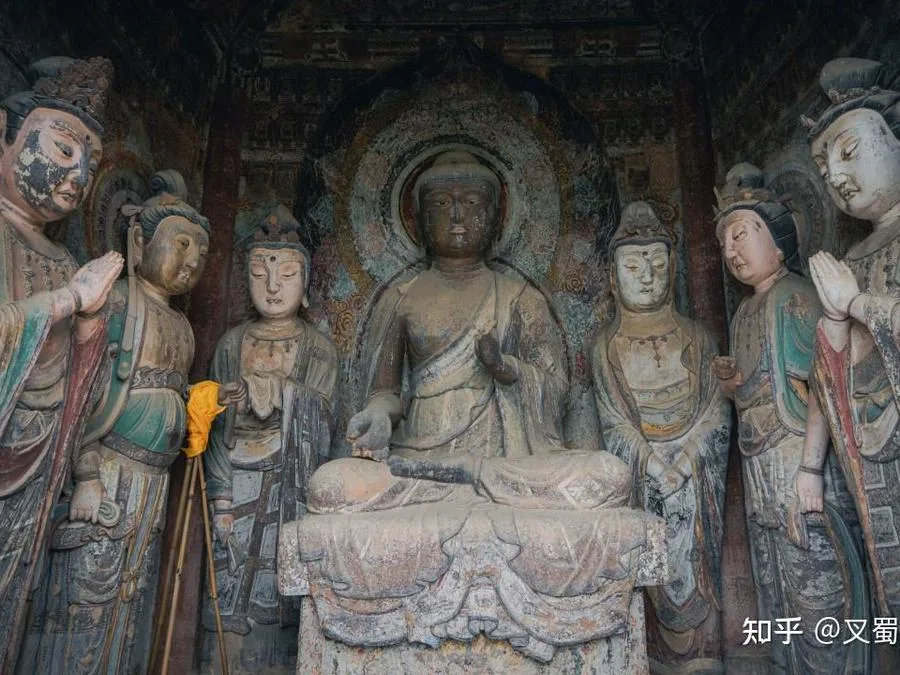
Cave 4, also known as the Upper Seven Buddhas Pavilion, is an awe-inspiring structure measuring 31.7 meters wide, 16 meters high, and 13 meters deep. Built during the Northern Zhou Dynasty by Li Chongxin, the Grand Commander of Qinzhou, for his grandfather’s blessing, this cave is a grand palace-style grotto. The entire cave is built into the mountain, with a roof featuring a hipped-gable design. The roof structure, including the ridge, chiwei (decorative fish tail), and tiles, are intricately carved into the rock.
The lower part of the cave showcases seven niches in a row, each with a pointed canopy. These niches are adorned with flame-shaped jewels and intricate floral designs, with drapes hanging from the sides. The ends feature sculpted auspicious animals like dragons, phoenixes, and elephants holding tassels in their mouths. Inside each niche, there is an octagonal pillar at each corner, with lotus bud decorations at the intersections of the pillars and rods, blending structural necessity with aesthetic elegance. This design emulates ancient Buddhist altars.
Each niche houses a Buddha statue, making a total of seven Buddhas in the cave. The front eaves are supported by eight large stone columns, each 7.3 meters tall and 1.2 meters in diameter, with lotus-shaped bases. The columns are decorated with complex architectural elements, including large brackets and beams. The ceiling features divided panels, and the overall structure is grand and imposing. This cave is the largest palace-style grotto in China, surpassing similar caves in Dunhuang, Yungang, Longmen, and Tianlongshan in both scale and decoration. Originally, the cave had six additional central stone columns supporting the roof, but these were destroyed during a significant earthquake in 600 AD, leaving only the columns on the east and west sides intact along with a small portion of the ceiling.
Cave 13 (Upper Seven Buddhas Pavilion)
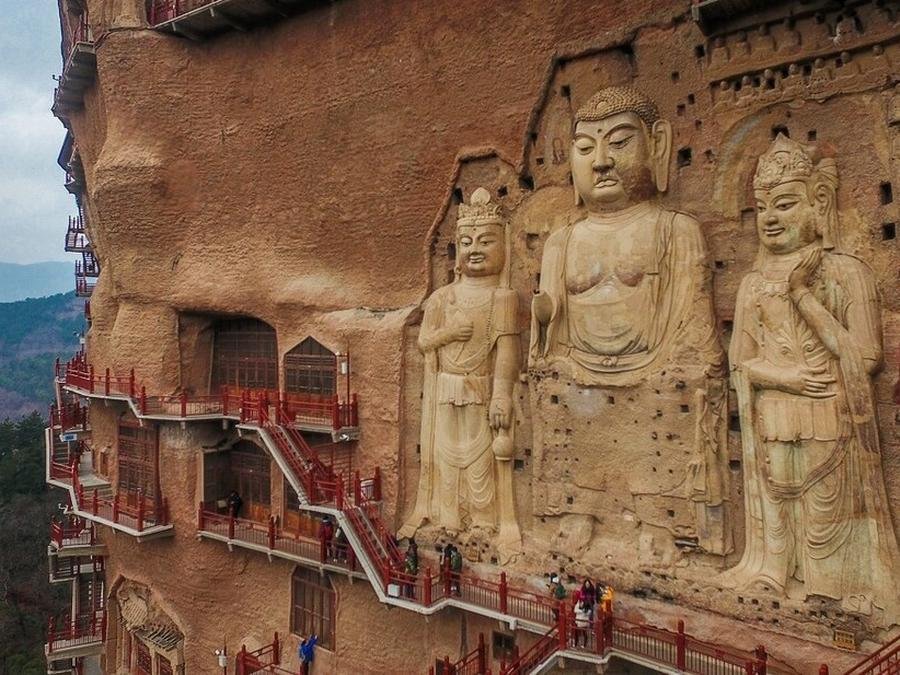
Cave 13, commonly referred to as the “Eastern Cliff Great Buddha,” is located in the middle section of the eastern cliff. Initially carved during the Sui Dynasty and refurbished during the Southern Song Dynasty, this shallow niche is nearly square, measuring 17 meters high and 18 meters wide. It features high-relief stone carvings covered with clay, depicting one Buddha and two Bodhisattvas. Cave 13 houses the largest group of stone-carved clay sculptures in Maijishan.
The central figure is Amitabha Buddha, standing 15.7 meters tall. The Buddha’s face is full and round, with low-relief coiled hair and a fleshy protuberance (ushnisha) on the top of the head. The Buddha has long, curved eyebrows, downcast eyes, and slightly upturned corners of the mouth, exuding a serene and compassionate demeanor. The ears are closely set against the cheeks, and the neck features three engraved lines, resembling silkworm segments. The statue sits with a straight back and a prominent chest, with feet resting on a lotus pedestal. The Buddha is depicted wearing an inner garment and an outer robe with flowing drapery lines. Although the hands are missing, it is inferred from the remnants that the left hand was placed on the left knee while the right hand was raised in a gesture of fearlessness and granting wishes. The expression on the Buddha’s face combines solemnity with a touch of compassion, as if gazing upon the myriad beings of the world.
Cave 44 (Oriental Smile)
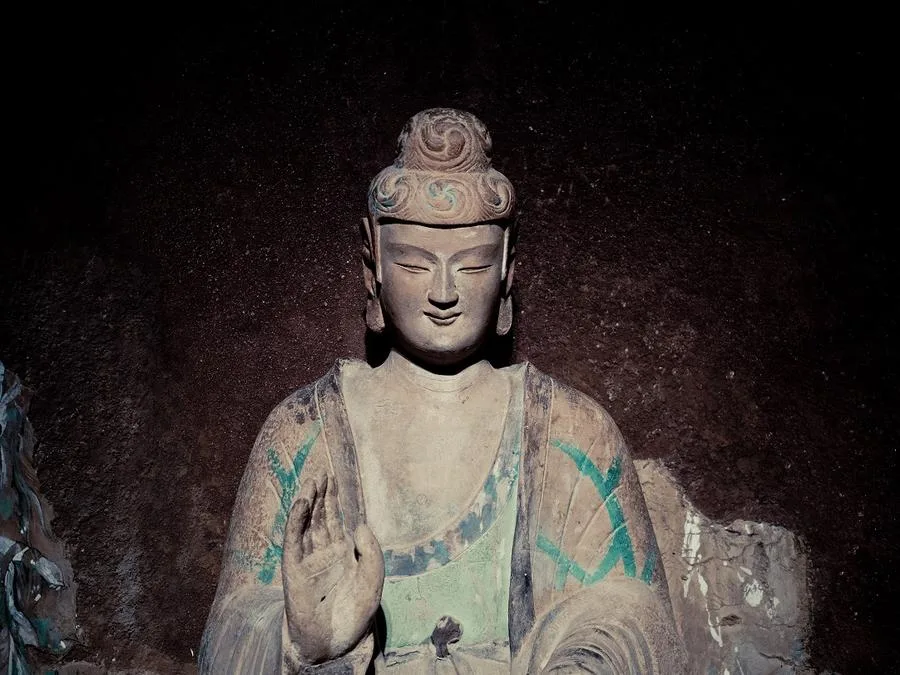
Cave 44 of the Maijishan Grottoes is renowned for its main Buddha statue, famously referred to as the “Oriental Smile.” This Buddha, with its downcast eyes and gentle smile, exudes a serene and compassionate presence. The statue is believed to be modeled after Empress Yifu, the wife of Emperor Wen of the Western Wei Dynasty, and was sculpted by Prince Wudu to honor his mother. This connection lends the statue an especially tender and feminine quality, making it a symbol of maternal grace and kindness. The “Oriental Smile” of this Buddha has captivated researchers and visitors alike, symbolizing peace and benevolence.
Cave 98 (Western Cliff Great Buddha)
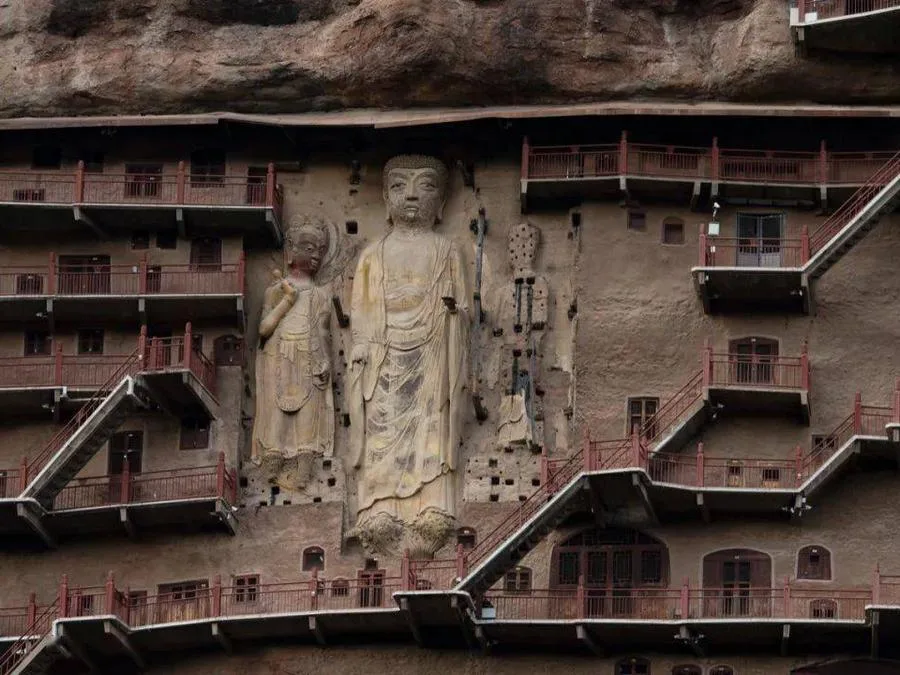
Cave 98, also known as the “Western Cliff Great Buddha,” is situated in the middle section of the western cliff. This grotto features a vertical rectangular relief, housing a large Buddha flanked by two Bodhisattvas. The entire sculpture is 14 meters high, 10 meters wide, and 1 meter deep. The central standing Buddha, towering at 12.2 meters, was originally crafted during the Northern Wei Dynasty and has undergone numerous restorations during the Northern Zhou, Song, Yuan, Ming, and Qing dynasties. As a result, the original appearance has largely been lost.
The current Buddha statue features a flat, tightly coiled hair bun typical of Song and Yuan dynasty sculptures, with a prominent ushnisha (a cranial protuberance symbolizing wisdom). The face is painted in vibrant red hues, with a broad forehead and a slender jawline. The eyebrows are curved, with three arc lines above, and the eyes gaze straight ahead, with slightly drooping corners and prominent lower eyelids. The nose is high and the mouth broad, with corners turned down slightly. The ears are short and slightly flared outwards, with three silkworm segment-like lines engraved on the neck. These characteristics exhibit a blend of Ming and Qing dynasty clay sculpture features. The Buddha’s short neck, sloping shoulders, and prominent chest and abdomen complete the majestic yet compassionate figure.
Cave 121 (Whispering Secrets)

Cave 121 at Maijishan Grottoes is a square-shaped cave with a domed ceiling, measuring 2.53 meters in height, 2.36 meters in width, and 2.13 meters in depth. This cave features deep niches on its central, left, and right walls, each housing a statue of Buddha. Although these statues underwent surface repairs during the Song Dynasty, a closer inspection reveals that the original Northern Wei sculptures remain well-preserved beneath the Song modifications.
The central niche is particularly striking, with small round sculptures of disciples adorning the upper sides, five on each side. These detailed figures add a layer of depth and historical context to the main Buddha sculptures, demonstrating the intricate artistry of the time.
One of the most enchanting features of Cave 121 is the pair of sculptures located on the right side of the main Buddha niche. This group includes a Bodhisattva and a disciple, depicted with their shoulders gently touching and heads inclined towards each other, sharing a secretive, sweet smile. This captivating scene, often referred to as “Whispering Secrets,” showcases the delicate and expressive craftsmanship that characterizes the Maijishan Grottoes.
Cave 127 (Richest Murals)
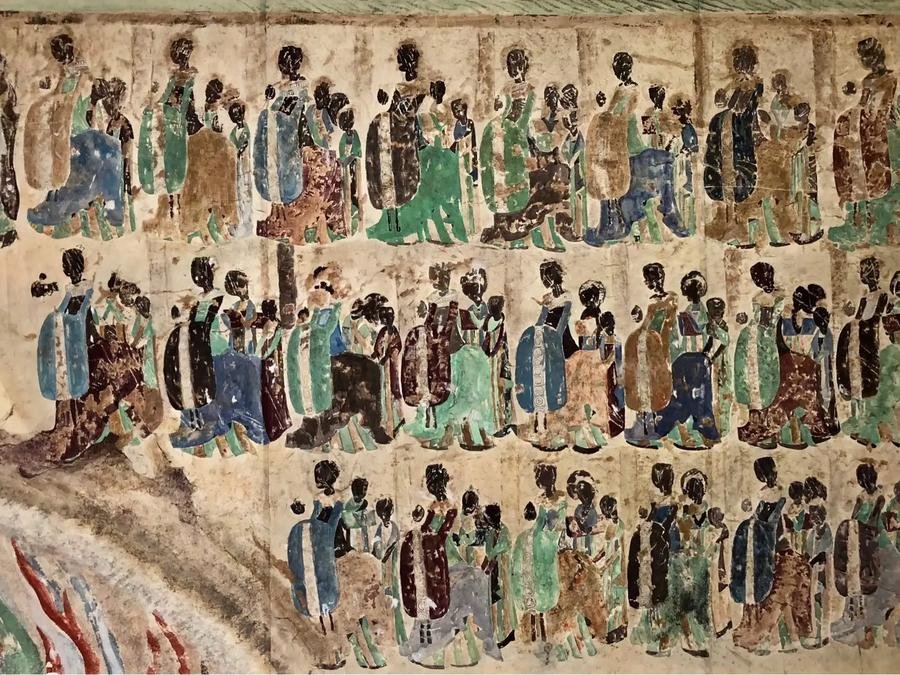
Cave 127 is a rectangular cave with a tent-like ceiling, measuring 8.0 meters in width, 4.0 meters in depth, and 4.0 meters in height. The front wall features an entrance, while the main, left, and right walls each have a niche housing a Buddha statue. The remaining wall surfaces are adorned with intricate murals, making Cave 127 the richest in wall paintings among the Maijishan Grottoes.
The murals depict various Buddhist sutras and stories, including the Western Pure Land Transformation, Vimalakirti Sutra Transformation, Nirvana Sutra Transformation, Hell Transformation, Shanzi Jataka, Ten Virtues and Ten Evils, the departure of Indra, and the Seven Buddhas. These murals are among the earliest and largest sutra story paintings in China.
One of the most notable murals is the “Shanzi Jataka,” which is 7.2 meters long and 1.4 meters high. This mural narrates the story of Prince Shanzi through a series of interconnected scenes, including the king’s procession, hunting, the accidental shooting of Prince Shanzi, his plea for forgiveness, visiting his blind parents, their lamentations, and the divine intervention that follows. The mural’s style is akin to a comic strip, seamlessly linking different events. The depiction of mountains, rivers, forests, and large rocks showcases unique compositions and techniques, setting it apart in early Chinese landscape painting.
Cave 133 (Yong Monk’s Innocent Face)

Cave 133 is celebrated for the charming statue of a young monk in Niche 9, sculpted during the Northern Wei period. This figure, standing less than one meter tall, depicts a child-like monk, appearing to be under ten years old. When viewed up close, the statue reveals a sweet smile on the monk’s innocent face, capturing a sense of youthful innocence and joy. This delightful and expressive sculpture has become one of the must-visit highlights of the Maijishan Grottoes, often evoking a smile from visitors as they connect with its endearing charm.
Cave 135 (Triad of Buddha Statues)

Originally, Cave 135 featured a triad of Buddha statues, created during the Northern Wei period. This layout included one central niche on the main wall and two side niches on the east and west walls. However, during the Northern Zhou period, two additional niches were added to the main wall, resulting in a five-Buddha arrangement.
The central niche on the main wall houses a group of sculptures depicting one Buddha flanked by two Bodhisattvas. The Buddha statue stands at 1.23 meters tall, with a prominent ushnisha (cranial protuberance) and downward-gazing eyes, conveying a serene and compassionate demeanor. The Buddha’s face is elongated, with delicate features, a slender neck, and narrow shoulders. The right hand is raised in the fear-not mudra (gesture), while the left hand is in the wish-granting mudra, though the fingers are slightly damaged. The statue is draped in a double-collared robe that flows gracefully.
The Bodhisattvas on either side of the Buddha are each 1.38 meters tall. Their bodies are flattened against the wall, with their upper torsos slightly leaning forward, as if attentively listening. They feature fan-shaped high buns, slender necks, and narrow shoulders, with round ornaments adorning their shoulders. The Bodhisattvas’ faces are clear and elegant, with half-open eyes and slightly parted lips, revealing subtle smiles. Their expressions convey a sense of devotion and reverence, reflecting their attentive listening to the Buddha’s teachings.
Vlog about Maijishan Grottoes
Map and Recommended Routes for Maijishan Grottoes

Route One
- Entrance (East Gate): Begin your tour at the East Gate.
- 168 Stone Steps: Ascend the historic 168 stone steps, offering a scenic climb and a sense of the grotto’s ancient architecture.
- Cave 3: Explore Cave 3, known for its intricate carvings and historical significance.
- Cave 4: Continue to Cave 4, featuring remarkable statues and detailed frescoes.
- Cave 5: Visit Cave 5, another highlight with its unique artistic elements.
- Sky Bridge (Tianqiao): Cross the Sky Bridge, which offers breathtaking views of the surrounding landscape and grottoes.
- Cave 98: Explore Cave 98, also known as “West Cliff Giant Buddha,” notable for its impressive statues.
- Cave 191: End your tour at Cave 191, featuring a blend of historical artistry and serene atmosphere.
- Exit (West Cliff Exit): Exit the grottoes from the West Cliff.
Route Two
- Entrance (East Gate): Start your journey at the East Gate.
- Cave 9: Visit Cave 9, showcasing early Buddhist art.
- Cave 13: Continue to Cave 13, featuring large-scale statues and intricate carvings.
- Cave 15: Explore Cave 15, another significant grotto with detailed sculptures.
- Cave 43 (Special Cave): Visit Cave 43, one of the special caves with unique historical and artistic importance.
- Cave 44 (Special Cave): Proceed to Cave 44, another special cave known for its detailed statues and murals.
- Central Area Passage: Navigate through the central area passage, connecting various key sites.
- Cave 78 (Special Cave): Visit Cave 78, featuring unique frescoes and sculptures.
- Cave 74 (Special Cave): Explore Cave 74, renowned for its intricate artistic details.
- Cave 94: Continue to Cave 94, offering a glimpse into the religious and cultural history of the grottoes.
- Cave 191: Conclude your tour at Cave 191, a serene and historically rich site.
- Exit (West Cliff Exit): Exit the grottoes from the West Cliff.
Significance of Maijishan Grottoes
Religious Significance
Maijishan Grottoes are primarily dedicated to Buddhism, featuring a diverse array of Buddhist iconography and themes. The grottoes depict the Three Buddhas, Seven Buddhas, and the Western Pure Land among other Buddhist concepts. The murals and sculptures illustrate important Buddhist narratives such as the Jataka Tales (stories of the Buddha’s past lives) and the Nirvana (the Buddha’s final enlightenment). For instance, the mural depicting the tale of Shanzi’s Generosity (Shanzi Ben Sheng) vividly represents the story of a prince sacrificing his own life to feed a hungry tiger, reflecting the core Buddhist values of compassion and selflessness.
These representations are more than mere artwork; they serve as a visual manifestation of Buddhist teachings. By illustrating the Buddha’s past lives and the path to enlightenment, Maijishan Grottoes offer spiritual guidance and inspire devotion among followers. The artistic depictions of deities, bodhisattvas, and celestial beings like Flying Apsaras (Heavenly Maidens) encapsulate the spiritual aspiration to transcend the suffering of the earthly realm and achieve enlightenment.
Artistic Value
The artistic significance of Maijishan Grottoes is immense. The grottoes are renowned for their mud sculptures and murals, which vividly capture the aesthetic and spiritual aspirations of various dynastic periods.
- Northern Wei (386–534 AD) artists, known for their refined and serene Buddha statues, expressed a profound tranquility and wisdom in their works. These early sculptures often have a serene, otherworldly quality, demonstrating a move towards a more introspective and spiritual art form.
- The Western Wei (535–556 AD) and Northern Zhou (557–581 AD) periods are marked by a more subdued and earnest approach to Buddhist art, characterized by simpler, yet emotionally resonant sculptures.
- Sui (581–618 AD) and Tang (618–907 AD) period sculptures show greater detail and lifelike quality, reflecting the era’s emphasis on religious devotion and the blossoming of Buddhist art.
- The Song (960–1279 AD) era brought a realistic portrayal of robes and expressions, showing a refined and dignified artistic style.
Overall, the artistic achievements of Maijishan Grottoes reveal the evolution of Buddhist art over centuries, reflecting changing aesthetic preferences and deeper spiritual insights.
Architectural Value
Architecturally, Maijishan Grottoes are a marvel of ancient engineering. Carved into the sheer cliffs of Maijishan Mountain, the grottoes feature an intricate network of cave temples and hanging corridors that ascend the mountainside in a manner reminiscent of a honeycomb. This impressive feat of construction creates a dramatic and majestic three-dimensional architectural complex.
- The cave temples are modeled after traditional wooden halls, complete with roof-like structures and decorative elements that imitate the look of wooden beams and eaves, a technique that demonstrates the artists’ innovative use of stone to replicate wooden architectural forms.
- The design of the grottoes often eschews central pillars, which is unusual in Buddhist cave temples, making Maijishan’s layout distinct from other major grotto sites like Dunhuang, Yungang, or Longmen. This feature highlights the local architectural innovation and adaptation to the natural landscape.
The hanging walkways and cliffside galleries offer a breathtaking experience as visitors traverse these ancient spaces, marveling at the craftsmanship and the sheer audacity of the construction.

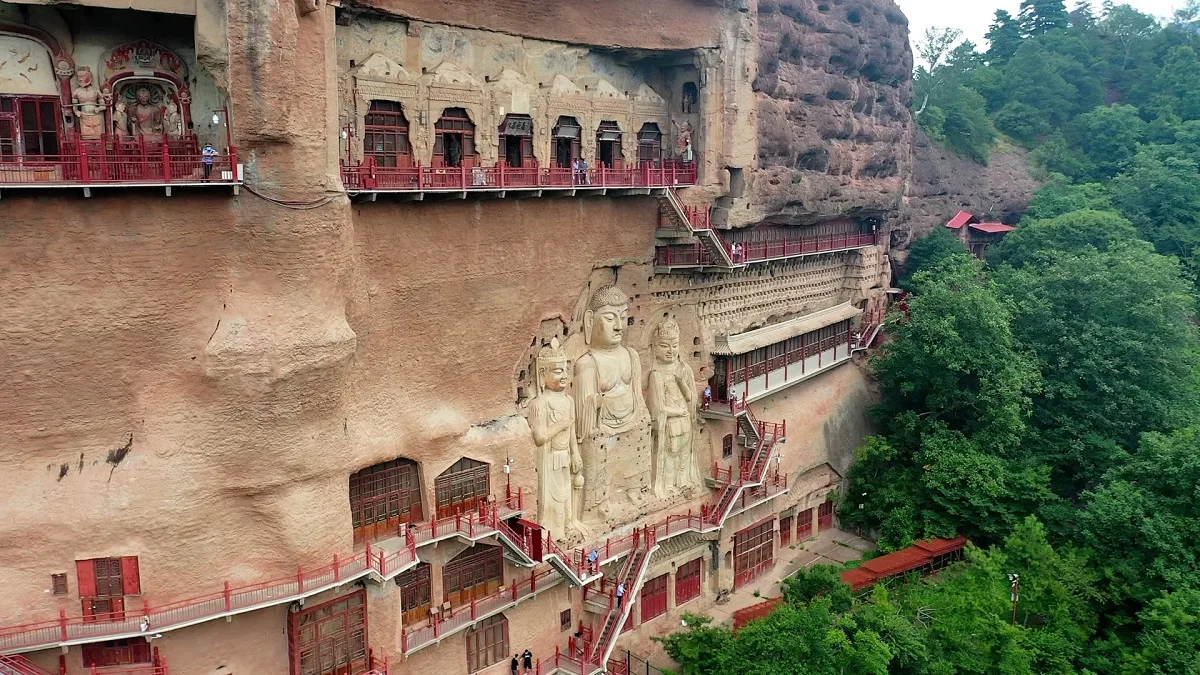




The Maijishan Grottoes have a great experience outside of holidays, with zero waiting time. You might even have to wait a bit to gather a group for the shuttle bus. I took a taxi there and used public transportation to return to Tianshui city. I suggest that if you’re short on time, it’s better to take a taxi or share a ride because the bus is really slow and hard to catch. (During the off-peak season, the bus frequency may… Read more »
Before entering, please confirm whether you want to see the special caves. The price for the special caves ranges from 100 to 180 yuan. If you buy a ticket for the special caves, you can also get a guided tour of the regular caves. Cave 133 is a must-see, as you can see the smiling monks and the magical eyes of the Buddha. Cave 127 is mainly for viewing murals, which have a completely different style than those in Dunhuang,… Read more »
I encountered an excellent tour guide at the Maijishan Grottoes and finally saw the cave I’ve been longing to visit. The real experience is far beyond what pictures can convey. There weren’t many people, so we could take our time exploring. Although it was cloudy, the sun came out as we descended, warming us up instantly. It was truly a worthwhile trip.
It’s the off-season now, and the regular routes don’t differentiate between Line 1 and Line 2, which allows for more sightseeing. However, there isn’t enough time to visit the special caves.
Visiting the Maijishan Grottoes during the off-season means there are far fewer people. The overall experience was excellent. The guide service in the scenic area costs 120 yuan and can accommodate up to 10 people. The explanations provided were thorough and very detailed.
The transportation to attractions in Tianshui is really convenient. There are direct buses from both the train station and the high-speed rail station to the Maijishan Grottoes. From the high-speed rail station, you can take Bus 5 for 10 RMB, or Bus 60 for 7 RMB (the bus driver mentioned that there’s one every 30 minutes or on the hour). From the train station, Bus 34 runs every ten minutes. Just ride to the last stop, and you can also… Read more »
The route for visiting the Maijishan Grottoes is strictly limited. Although the experience is quite impressive, the high ticket price still leaves visitors feeling unsatisfied, especially after purchasing a special grotto ticket and only listening to the guide for an hour. This does not allow enough time to carefully observe the regular grottoes along the way.